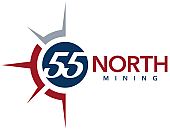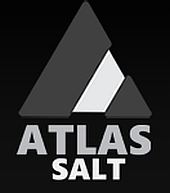 Mining.com: Optimism for metals clashes with reality for juniors ahead of PDAC
Mining.com: Optimism for metals clashes with reality for juniors ahead of PDAC
https://www.mining.com/optimism-for-metals-clashes-with-reality-for-juniors-ahead-of-pdac/
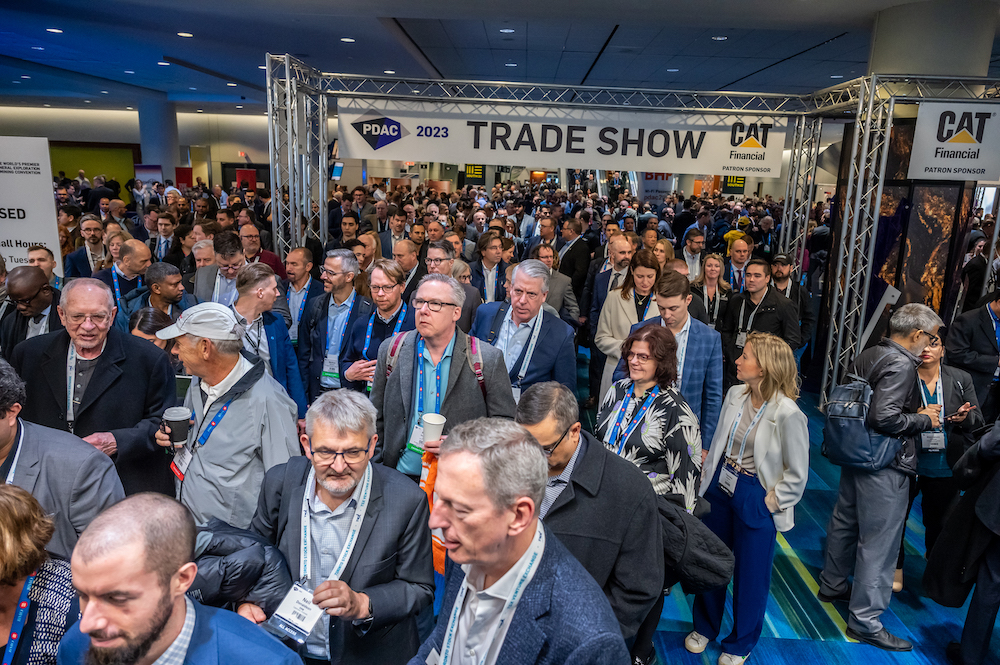
Increasing funding for battery metal and uranium projects versus gold brings home the global energy transition but big financing deals for preproduction companies have almost disappeared, new figures show ahead of the country’s largest mining showcase.
The data, from the Prospectors and Developers Association of Canada (PDAC) which holds its 92nd annual convention Mar. 3-6 in Toronto, shows just how much junior miners are struggling, despite a growing international recognition of mining’s importance.
Last year, for the first time in a decade, there wasn’t a single financing above C$125 million on the TSX Venture Exchange, where many junior mining exploration companies are listed. Deals at the C$200 million level had previously been fairly common, Jeff Killeen, policy and program director for PDAC, said in an interview.
“The juniors, particularly those outside of the critical mineral sphere, are facing more hurdles in terms of accessing capital,” Killeen said. “When they’re accessing it, there’s just smaller deals being done.”
Total financing on the TSX Venture has fallen for three years running, with the exchange falling far behind the main board in equity raised for the first time since 2017. Last year, the gap between the two grew to C$1.1 billion. With risk capital suffering overall though, junior miners actually “punched above their weight,” accounting for three quarters of all funds raised on the Venture Exchange last year.
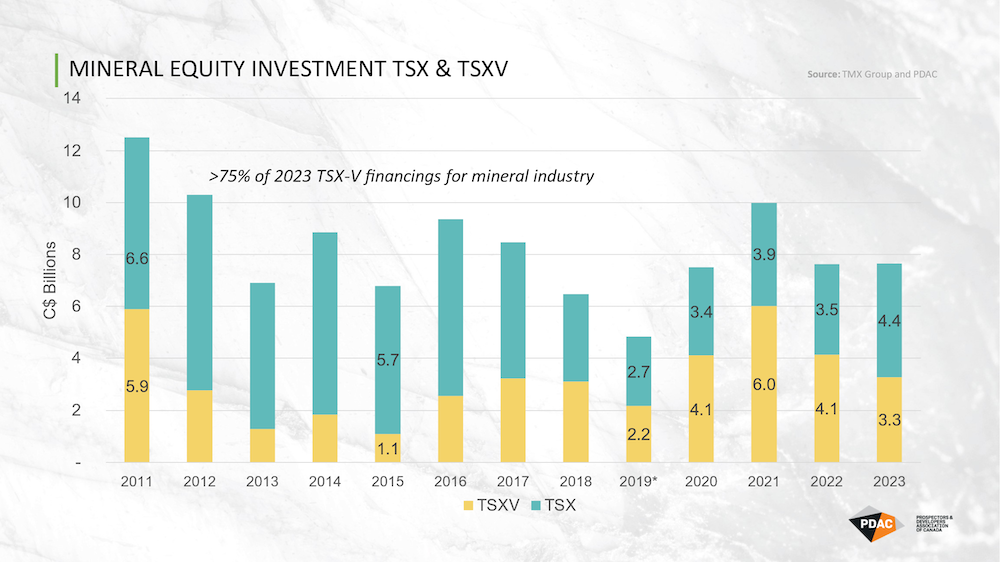
Nearly C$8 billion in equity was raised on all Canadian exchanges last year for mining, up slightly from 2022, and on par with the 10-year average for fundraising.
“Arguably, the availability of capital hasn’t moved or materially improved over the last 10 years,” Killeen said. “It hasn’t declined, but it does seem to be moving in different directions.”
Precious metals exploration still draws the lion’s share of funding with C$2.1 billion raised last year. But PDAC figures show other metals gaining ground. Total capital for base and battery metals plus uranium has roughly tripled since 2020 to nearly C$2 billion, while funding for precious metals exploration shrunk by 19% last year alone.
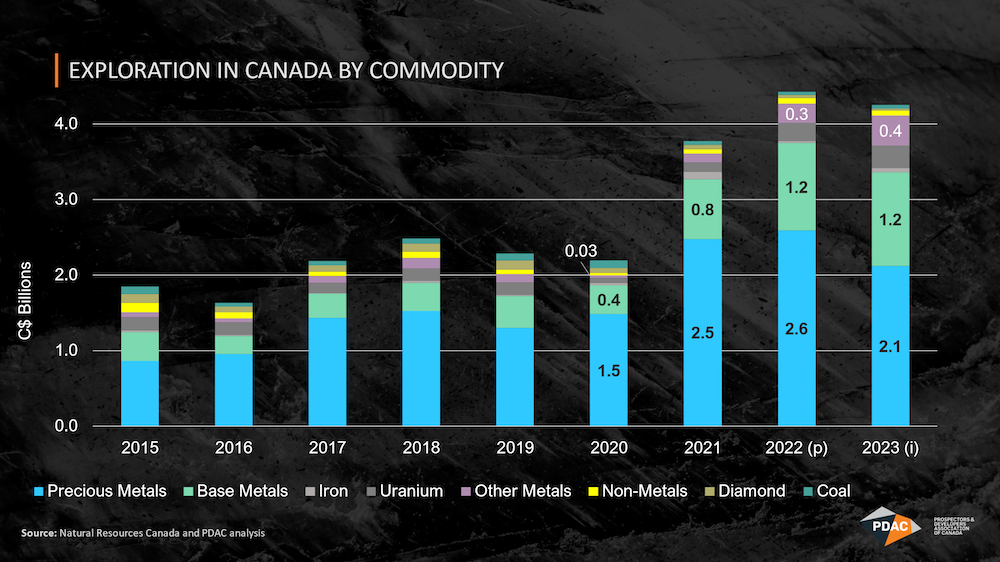
More governments around the world waking up to the crucial role of metals in the energy transition is being reflected in new interest among international delegates coming to the PDAC convention, Killeen says.
“The global conversation is changing,” Killeen added. “There’s a growing awareness (about critical minerals) and people are recognizing PDAC is the place to come to.
“There’s a real global commitment that we’re seeing towards electrification, clean technology, and emissions reduction that’s only going to happen if the mineral industry is brought to that table.”
Mindful of the challenges its membership is facing, PDAC is aiming to make it easier for juniors to connect with potential investors this year by bringing corporate presentations onto the Investors Exchange floor for the first time.
The program also includes a series of critical minerals-related sessions that cross over between the technical program and the policy programs, as well as integrated sessions between the capital markets and the Indigenous and sustainability programs.
Advocacy
While capital has been difficult to access for at least the past three years, the federal government has recently put in place policies and incentives that amount to end-to-end supports for mineral companies, from exploration through to project construction.
The packages are part of its Critical Minerals Strategy, introduced in late 2022, which commits C$3.8 billion in total spending. The supports for mining are historic — but there is some room for improvement, according to PDAC.
The C$1.5 billion over seven years Critical Mineral Infrastructure Fund, for example, should be revamped as a perennial fund, Killeen says — especially considering the steep price tag of most infrastructure. (Initial applications for this funding, which will only dole out a total of C$300 million this year, are due Feb. 29.)
And PDAC wants to ensure that the Clean Technology Manufacturing input tax credit, which gives a 30% cash-back credit for critical minerals extraction and processing, can be applied to polymetallic projects that may contain precious metals as well as critical minerals.
As for regulatory initiatives, PDAC will be involved in hot-button topics such as how to prevent short-sellers from targeting junior miners — an issue that the Save Canadian Mining group, supported by big industry names such as Eric Sprott and Rob McEwen, has been asking regulators to address. The Canadian Investment and Regulatory Organization and the Canadian Securities Administrators said last year they would be forming a working group in early 2024 to study short-selling issues.
“We’ve been asking for what we think are logical changes to regulations around short selling for several years,” Killeen said.
In 2021, PDAC called for an alternative uptick rule (which would prevent short-selling in a stock that has dropped more than 10% in one day) to be instated, bringing Canada in line with U.S. regulations.
“We also at that time and have continued to ask for a more comprehensive framework for activist short sellers, so that there is more of a balance in our home marketplace with respect to disclosure.”.
PDAC is also advocating for changes to the flow-through regime that could attract a broader set of investors. The flow-through charity tax credit, which allows juniors to transfer exploration tax credits to investors, is used primarily by high earners. A change to the alternative minimum tax is yet to be formalized in any legislation, but the government has said is effective as of Jan. 1. It could jeopardize an investment stream that has raised nearly C$4 billion for exploration in Canada in the last three years.
Killeen says flow-through shares could be more appealing to a broader slice of investors if capital gains on the shares were assessed based on the issue price, rather than on a nil-cost basis as they currently are.
Optimism, despite near-term hurdles
As commodity prices have tumbled (with the exception of uranium and gold), challenges for juniors are likely to continue — at least in the short-term. But the conversation around mining globally is radically more supportive than even five years ago, leaving Killeen optimistic for juniors in the medium to long-term.
“If you think five or 10 years down the road from where we are today, I don’t know I’ve ever seen an overall environment that’s been as positive towards what mineral exploration and mining means for the future.”







